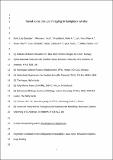Files in this item
Naval sonar disrupts foraging behaviour in humpback whales
Item metadata
| dc.contributor.author | Sivle, Lise D. | |
| dc.contributor.author | Wensveen, Paulus Jacobus | |
| dc.contributor.author | Kvadsheim, Petter | |
| dc.contributor.author | Lam, Frans-Peter A. | |
| dc.contributor.author | Visser, Fleur | |
| dc.contributor.author | Cure, Charlotte | |
| dc.contributor.author | Harris, Catriona M | |
| dc.contributor.author | Tyack, Peter Lloyd | |
| dc.contributor.author | Miller, Patrick | |
| dc.date.accessioned | 2017-12-30T00:31:35Z | |
| dc.date.available | 2017-12-30T00:31:35Z | |
| dc.date.issued | 2016-12-29 | |
| dc.identifier | 230395866 | |
| dc.identifier | c9f7ddcf-1414-404b-b2ba-982ca3acfad9 | |
| dc.identifier | 85007575663 | |
| dc.identifier | 000394183600016 | |
| dc.identifier.citation | Sivle , L D , Wensveen , P J , Kvadsheim , P , Lam , F-P A , Visser , F , Cure , C , Harris , C M , Tyack , P L & Miller , P 2016 , ' Naval sonar disrupts foraging behaviour in humpback whales ' , Marine Ecology Progress Series , vol. 562 , pp. 211-220 . https://doi.org/10.3354/meps11969 | en |
| dc.identifier.issn | 0171-8630 | |
| dc.identifier.other | ORCID: /0000-0001-9198-2414/work/60887675 | |
| dc.identifier.other | ORCID: /0000-0002-8409-4790/work/60887820 | |
| dc.identifier.uri | https://hdl.handle.net/10023/12394 | |
| dc.description.abstract | Modern long-range naval sonars are a potential disturbance for marine mammals and can cause disruption of feeding in cetaceans. We examined the lunge-feeding behaviour of humpback whales Megaptera novaeangliae before, during and after controlled exposure experiments with naval sonar by use of acoustic and motion sensor archival tags attached to each animal. Lunge-feeding by humpback whales entails a strong acceleration to increase speed before engulfing a large volume of prey-laden water, which can be identified by an acoustic signature characterized by a few seconds of high-level flow-noise followed by a rapid reduction, coinciding with a peak in animal acceleration. Over 2 successive seasons, 13 humpback whales were tagged. All were subject to a no-sonar control exposure, and 12 whales were exposed to 2 consecutive sonar exposure sessions, with 1 h between sessions. The first sonar session resulted in an average 68% reduction in lunge rate during exposure compared to pre-exposure, and this reduction was significantly greater than any changes observed during the no-sonar control. During the second sonar session, reduction in lunge rate was 66% during sonar exposure compared to the pre-exposure level, but was not significant compared to the no-sonar control, likely due to a larger inter-individual variability because some individuals appeared to have habituated whereas others had not. Our results indicate that naval sonars operating near humpback whale feeding grounds may lead to reduced foraging and negative impacts on energy balance. | |
| dc.format.extent | 700604 | |
| dc.language.iso | eng | |
| dc.relation.ispartof | Marine Ecology Progress Series | en |
| dc.subject | Humpback whale | en |
| dc.subject | Megaptera novaeangliae | en |
| dc.subject | Naval sonar | en |
| dc.subject | Behavioral response | en |
| dc.subject | Lung feeding | en |
| dc.subject | GC Oceanography | en |
| dc.subject | QH301 Biology | en |
| dc.subject | QL Zoology | en |
| dc.subject | SDG 14 - Life Below Water | en |
| dc.subject.lcc | GC | en |
| dc.subject.lcc | QH301 | en |
| dc.subject.lcc | QL | en |
| dc.title | Naval sonar disrupts foraging behaviour in humpback whales | en |
| dc.type | Journal article | en |
| dc.contributor.sponsor | Office of Naval Research | en |
| dc.contributor.institution | University of St Andrews. School of Biology | en |
| dc.contributor.institution | University of St Andrews. Scottish Oceans Institute | en |
| dc.contributor.institution | University of St Andrews. Centre for Research into Ecological & Environmental Modelling | en |
| dc.contributor.institution | University of St Andrews. Centre for Social Learning & Cognitive Evolution | en |
| dc.contributor.institution | University of St Andrews. Marine Alliance for Science & Technology Scotland | en |
| dc.contributor.institution | University of St Andrews. Sea Mammal Research Unit | en |
| dc.contributor.institution | University of St Andrews. Sound Tags Group | en |
| dc.contributor.institution | University of St Andrews. Bioacoustics group | en |
| dc.contributor.institution | University of St Andrews. Institute of Behavioural and Neural Sciences | en |
| dc.identifier.doi | 10.3354/meps11969 | |
| dc.description.status | Peer reviewed | en |
| dc.date.embargoedUntil | 2017-12-29 | |
| dc.identifier.grantnumber | N00014-12-1-0204 | en |
This item appears in the following Collection(s)
Items in the St Andrews Research Repository are protected by copyright, with all rights reserved, unless otherwise indicated.

